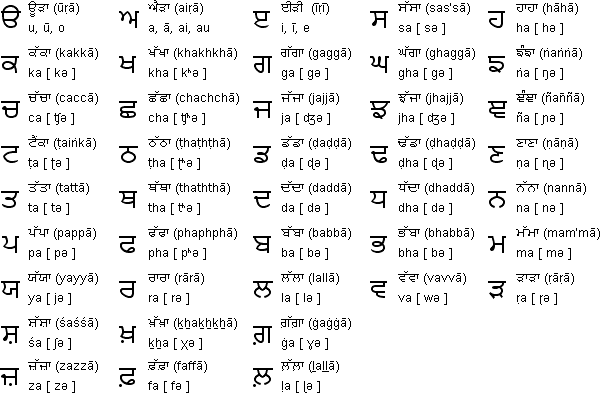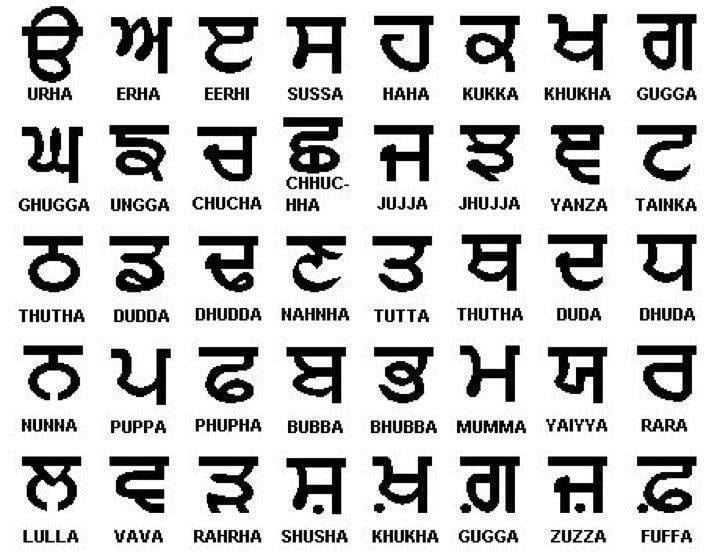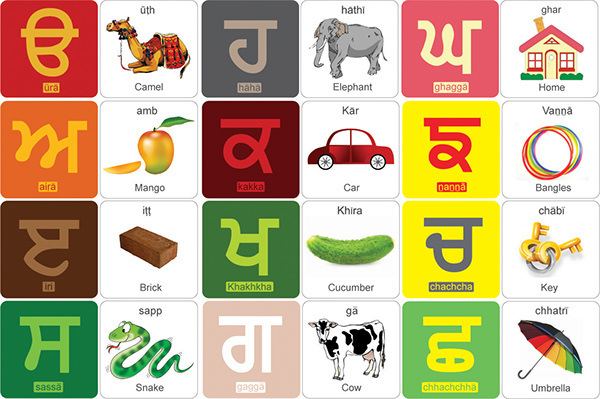Type Abugida Direction Left-to-right | Time period 16th century CE | |
Languages Predominantly:
Punjabi
Gurmukhi
Others:
Braj Bhasha
Khariboli
Sanskrit
Sindhi
Persian Parent systems Proto-Sinaitic
Phoenician
Aramaic
Brahmi
Gupta
Śāradā
Laṇḍā
Gurmukhi Sister systems Devanagari
Khojki
Takri | ||
Gurmukhi ([ɡʊɾmʊkʰi]; Gurmukhi: ਗੁਰਮੁਖੀ) is a Sikh script modified, standardized and used by the second Sikh Guru, Guru Angad (1563–1606). Gurmukhi is one of two scripts used for the Punjabi language, the other being Shahmukhi script. While the Punjabi Muslims use Shahmukhi to record Punjabi, Sikhs and Punjabi Hindus use Gurmukhi. The central scripture of Sikhism, Guru Granth Sahib is written in the Gurmukhī alphabet, in various dialects – including Lahnda (Western Punjabi), Braj Bhasha, Khariboli, Sanskrit, Sindhi and Persian – often coalesced under the generic title of Sant Bhasha.
Contents
- Origins
- Gurmukh Punjabi
- Consonants
- Subjoined letters
- Vowels
- Nasalisation tippi and bindi
- Gemination addak
- Halant
- Visarg
- Udaat
- Numerals
- Unicode
- Digitisation of Gurmukh manuscripts
- References

Modern Gurmukhī has thirty-eight consonants (akhar), 10 vowel symbols (lāga mātrā), two symbols for nasal sounds (pair bindi and ṭippī), and one symbol which duplicates the sound of any consonant (addak). In addition, four conjuncts are used: three subjoined forms of the consonants Rara, Haha and Vava, and one half-form of Yayya. Use of the conjunct forms of Vava and Yayya is increasingly scarce in modern contexts.

Origins

The Gurmukhi script has roots in the Brahmi script like most north Indian and west Chinese languages. In a cursory look, the Gurmukhi script appears different from other Indic scripts such as Bengali, Oriya, Tibetan or Devanagari, but a closer examination reveals they are similar except for angles and structural emphasis.
Notable features:


There are two major theories on how the Proto-Gurmukhī script emerged in the 15th century. G.B. Singh (1950), while quoting al-Biruni's Ta'rikh al-Hind (1030 CE), says that the script evolved from Ardhanagari. Al-Biruni writes that the Ardhanagari script was used in Bathinda and western parts of the Punjab in the 10th century. For some time, Bathinda remained the capital of the kingdom of Bhati Rajputs of the Pal clan, who ruled North India before the Muslims occupied the country. According to al-Biruni, Ardhanagari was a mixture of devanagari used in Ujjain and Malwa and Siddha Matrika or the last stage of Siddhaṃ script, a variant of the Śāradā script used in Kashmir. This theory is confusing as Gurmukhī characters have a very close resemblance with "Siddh Matrika" inscriptions found at some sacred wells in Punjab as G.B Singh notes, one being the hathur inscription dating to just before the brith of Guru Nanak. Siddh Matrika seems to have been the prevalent script for devotional writings in Punjab right up to the founding of Sikhism, after which its successor Gurmukhī appears.
Pritam Singh (1992) has also traced the origins of Gurmukhī to the Siddha Matrika. "Siddha Matrika" along with its sister Takri alphabet has its origins in the Śāradā script of Kashmir.
Tarlochan Singh Bedi (1999) writes that the Gurmukhī script developed in the 10-14th centuries from the Devasesha stage of the Śāradā script, the intermediate phase being Siddha Matrika, before the final evolution into Gurmukhī. His argument is that from the 10th century, regional differences started to appear between the Śāradā script used in Punjab, the Hill States (partly Himachal Pradesh) and Kashmir. The regional Śāradā script evolved from this stage until the 14th century, when it starts to appear in the form of Gurmukhī. Indian epigraphists call this stage Devasesha, while Bedi prefers the name Pritham Gurmukhī or Proto-Gurmukhī.
The Sikh gurus adopted proto-Gurmukhī to write the Guru Granth Sahib, the religious scriptures of the Sikhs. Other contemporary scripts used in the Punjab were Takri and the Laṇḍā scripts. The Takri alphabet developed through the Devasesha stage of the Śāradā script and is found mainly in the Hill States such as Chamba, Himachal Pradesh, where it is called Chambyali, and in Jammu Division, where it is known as Dogri. The local Takri variants got the status of official scripts in some of the Punjab Hill States, and were used for both administrative and literary purposes until the 19th century. After 1948, when Himachal Pradesh was established as an administrative unit, the local Takri variants were replaced by Devanagari.
Meanwhile, the mercantile scripts of Punjab known as the Laṇḍā scripts were normally not used for literary purposes. Landa means alphabet "without tail", implying that the script did not have vowel symbols. In Punjab, there were at least ten different scripts classified as Laṇḍā, Mahajani being the most popular. The Laṇḍā scripts were used for household and trade purposes. Compared to the Laṇḍā, Sikh Gurus favoured the use of Proto-Gurmukhī, because of the difficulties involved in pronouncing words without vowel signs.
The usage of Gurmukhī letters in Guru Granth Sahib meant that the script developed its own orthographical rules. In the following epochs, Gurmukhī became the prime script applied for literary writings of the Sikhs. Later in the 20th century, the script was given the authority as the official script of the Punjab, India while in the Punjab, Pakistan the Persianate Shahmukhi alphabet is still in use.
Gurmukhī Punjabi
Although the word Gurmukhī has been commonly translated as "from the Mouth of the Guru," the term used for the Punjabi script has somewhat different connotations. The opinion traditional scholars for this is that as the Sikh holy writings, before they were written down, were uttered by the Gurus, they came to be known as Gurmukhī or the "Utterance of the Guru". Consequently, the script that was used for scribing the utterance was also given the same name. The term that would mean "by the Guru's mouth" would be "Gurmū̃hī̃," which sounds considerably different but looks similar in Latin script.
However, the prevalent view among Punjabi linguists is that as in the early stages the Gurmukhī letters were primarily used by Gurmukhs (literally, those who follow or face the Guru), the script came to be associated with them. Another view is that as the Gurmukhs, in accordance with the Sikh belief, used to meditate on the letters ਵ, ਹ, ਗ, ਰ which jointly form ਵਾਹਿਗੁਰੂ or Praise of Guru in Sikhism, these letters were called Gurmukhī, or "of the Gurmukhs". Later, the whole script came to be known as Gurmukhī.
Consonants
The Gurmukhī alphabet contains thirty-five letters. The first three are distinct because they form the basis for vowels and are not consonants, and except for æṛa are never used on their own. See the section on vowels for further details.
ਙ |ŋɑŋːɑ̃ | and ਞ |ɲəɲːɑ̃ | are rarely used. They cannot begin a syllable or be placed between two consonants, and occur most often as an allophone of n before specific consonant phonemes.
The pronunciation of ਵ will vary between v and w depending on the word.
In addition to these, there are six consonants created by placing a dot (bindi) at the foot (pair) of the consonant (these are not present in Sri Guru Granth Sahib). These are used most often for loanwords, though not exclusively:
|ləlːɑ pɛɾ bɪnd̪i| was only recently added to the Gurmukhī alphabet. It was not a part of the traditional orthography, the phonological difference between 'l' and 'ɭ' was not reflected in the script. Some sources do not consider it a separate letter.
"Subjoined" letters
Three "subscript" letters are utilised in Gurmukhī: forms of ਹ(h), ਰ(r), and ਵ(v). ਰ(r) and ਵ(v) are used to make consonant clusters and behave similarly; subjoined ਹ(h) raises tone.
Vowels
Gurmukhī is similar to Brahmi scripts in that all consonants are followed by an inherent 'a' sound (unless at the end of a word when the 'a' is usually dropped). This inherent vowel sound can be changed by using dependent vowel signs which attach to a bearing consonant. In some cases, dependent vowel signs cannot be used – at the beginning of a word or syllable for instance – and so an independent vowel character is used instead.
Independent vowels are constructed using three bearer characters: Ura (ੳ), Aira (ਅ) and Iri (ੲ). With the exception of Aira (which represents the vowel 'a') they are never used without additional vowel signs.
Dotted circles represent the bearer consonant. Vowels are always pronounced after the consonant they are attached to. Thus, Sihari is always written to the left, but pronounced after the character on the right.
Nasalisation: tippi and bindi
Ṭippi ( ੰ ) and bindi ( ਂ ) are used for producing a nasal phoneme depending on the following obstruent or a nasal vowel at the end of a word. All short vowels use ṭippi and all long vowels are paired with bindi except for Dulankar ( ੂ ), which uses ṭippi instead. Older texts may follow other conventions.
Bindi ( ਂ ) is also used for nasalisation.
Gemination: addak
The use of addak ( ੱ ) indicates that the following consonant is geminate. This means that the subsequent consonant is doubled or reinforced.
Halant
The halant (੍) character is not used when writing Punjabi in Gurmukhī. However, it may occasionally be used in Sanskritised text or in dictionaries for extra phonetic information. When it is used, it represents the suppression of the inherent vowel.
The effect of this is shown below:
ਕ – kə ਕ੍ – kVisarg
The visarg symbol (ਃ U+0A03) is used very occasionally in Gurmukhī. It can either represent an abbreviation (like period is used in English) or it can act like a Sanskrit Visarga where a voiceless 'h' sound is pronounced after the vowel.
Udaat
The udaat symbol (ੑ U+0A51) occurs in older texts and indicates a high tone.
Numerals
Gurmukhī has its own set of digits, used exactly as in other versions of the Hindu-Arabic numeral system. These are used extensively in older texts. In modern contexts, they have been replaced by standard Hindu-Arabic numerals.
Unicode
Gurmukhī script was added to the Unicode Standard in October, 1991 with the release of version 1.0. Many sites still use proprietary fonts that convert Latin ASCII codes to Gurmukhī glyphs.
The Unicode block for Gurmukhī is U+0A00–U+0A7F:
Digitisation of Gurmukhī manuscripts
Panjab Digital Library has taken up digitisation of all available manuscripts of Gurmukhī Script. The script is just 500 years old, hence a lot of literature written in all these years is still traceable. Panjab Digital Library has digitised over 5 million pages from different manuscripts and most of them are available online.
